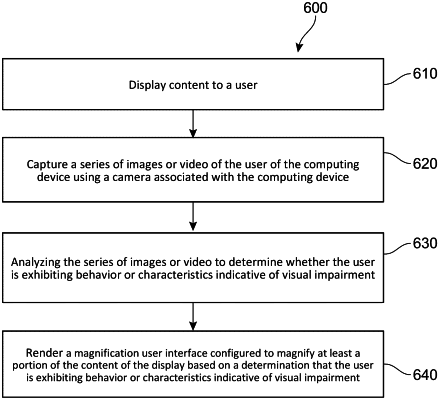| CPC G09G 5/373 (2013.01) [G06F 3/012 (2013.01); G06F 3/013 (2013.01); G06T 7/20 (2013.01); G06T 7/55 (2017.01); G06V 40/18 (2022.01); G06V 40/20 (2022.01); G06F 2203/011 (2013.01); G06T 2207/30201 (2013.01); G09G 2340/045 (2013.01); G09G 2354/00 (2013.01)] | 18 Claims |

|
1. A computing device comprising:
a processor; and
a computer-readable medium storing executable instructions for causing the processor to perform operations comprising:
capturing a series of images of a user using a camera associated with the computing device;
analyzing the series of images to determine whether the user is exhibiting behavior indicative of difficulty seeing content on a display by detecting eyes of the user in the series of images and determining that the user is squinting by detecting changes in an aspect ratio of a shape of the user's eyes, wherein detecting changes in the aspect ratio includes determining whether a ratio of a width of an eye opening to a height of the eye opening exceeds a predetermined threshold;
rendering a magnification user interface on the display configured to magnify at least a portion of the content of the display based on a determination that the user is exhibiting the behavior indicative of difficulty seeing content on a display;
tracking movement of the user based on the series of images captured by the camera by providing the series of images as an input to a neural network configured to estimate a position of a user's head and to generate first bounding box information representing a first bounding box around a predicted position of the user's head;
estimating a distance of the user from the display of the computing device based on a size of the first bounding box; and
modifying one or more attributes of the magnification user interface based on the distance of the user from the display.
|